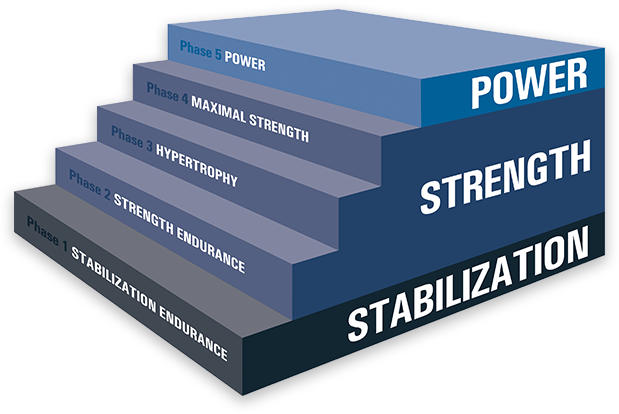One of my primary motivations for becoming a personal trainer is because I want to help people and add value to their lives. If I could help people improve their fitness, then I could help them quantifiably enhance their quality of life. In my book, that’s a value worth adding.
So, when it came time to figure out where to get my personal training certification, I looked all over the place. I landed on the National Academy of Sports Medicine (NASM). Not only did they come highly recommended by just about everywhere I looked, but they had a model that aligned with my values. NASM has a training method called the OPT model that is the perfect way to train anyone, no matter their fitness level.
Today I want to talk about the OPT model, explain what it is, and why we use it as the foundation for all of our training programs.
What is the OPT Model?
OPT stands for Optimum Performance Training. This model of training was developed by NASM based on scientific evidence and principles that progress individuals through five phases of training. The five phases are as follows:
- Stabilization Endurance
- Strength Endurance
- Hypertrophy
- Maximal Strength
- Power
These five phases can be grouped together into three levels, progressing like a staircase. The three levels are: 1) stabilization, 2) strength, and 3) power (as pictured in the image below).

The way the OPT model is designed to be a planned, systematic, and periodized training program. It doesn’t just focus on achieving a client’s goal by any means necessary. Instead, it seeks to improve all functional abilities of a client, including things like: flexibility, core stability, balance, strength, power, and cardiorespiratory endurance. So, no matter the goal, the OPT model can get you there while improving your overall fitness abilities.
How Does the OPT Model Work?
At its simplest, the OPT model follows the progression of the stairs to train a client, no matter what their end goal is. Although, how far up the stairs they go is entirely dependent upon the end goal. Let’s look at a couple different examples.
Weight Loss & Lean Muscle
Someone who is overweight usually has a pretty simple goal: lose weight. To accomplish this goal a client must do the following: 1) burn fat, and 2) build lean muscle. Let’s see how the OPT model can help this client.
After figuring out a goal, like losing 20 pounds, the work can begin. Being overweight, this person is very likely someone who does not get a lot of physical activity. Our fictional client has a desk job working 40 hours a week, and spends their evenings and weekends reading, playing video games, and binging shows on Netflix. They go on a walk occasionally, but that’s about the extent of their physical activity. This client would begin in Phase 1 of the OPT model: Stabilization Endurance.
Why Phase 1? Being inactive means they have lots of weak muscles, as well as muscles that are very likely being overworked because of the weak muscles. This muscle weakness leads to imbalances in posture I would notice in the client. Phase 1 focuses on strengthening these muscles, which will begin correcting these imbalances. This phase is important because we want to make sure all muscles are functioning as they should. There is no need use in building on a foundation if it is weak, right? So, we’re fixing all the cracks in the foundation before we start building. Exercises here would include lots of balance work & core work, doing reps slowly to get muscles firing correctly. After 4-6 weeks of stabilization work, this client would move to Phase 2.
With a stable foundation in place, the focus turns to Strength Endurance and the strength level of the OPT model. Another 4-6 weeks is spent here with a focus on doing lots of reps with lighter weights. The goal here is to build up the endurance of the muscular system, allowing them to work for longer periods before reaching exhaustion. Throughout this process, the client is burning calories and losing weight, but they are also building muscle which will increase their body’s metabolism. This increased metabolism will in turn increase their body’s natural ability to burn calories, leading to further weight loss while getting stronger.
Since this client’s particular goal is weight loss and building lean muscle, we would then advance them to Phase 3 of the OPT model: Hypertrophy. What is hypertrophy? It’s basically building bigger muscles. So, for the next 4 weeks the client would focus on lifting heavier weights and increasing the resistance placed on the body. They will do fewer reps than they had done in prior weeks, but they are doing more sets. This process will force cellular change that causes the muscles to grow.
Because this client’s goal is weight loss, they do not need to go any further up the OPT model. This means their next steps would be to cycle through Phases 1-3 again. Why? First, it gives the body a break and a chance to recover from the hard work it performed during Phase 3. Second, stabilization and strength endurance are always important to make sure the foundation remains strong, continuing to improve general fitness. Also, in addition to the OPT model, a client would also spend several hours a week doing cardio workouts to improve their cardiorespiratory fitness.
Bodybuilder
Our next client is a bodybuilder who is now enlisting the support of a personal trainer. Our path with this client is no different. Everyone needs a strong foundation upon which to build, so we begin at Phase 1, progress to Phases 2 & 3 like we did with the weight loss client. The only difference here is that this is a person who already has a certain level of fitness, so they would be using heavier weights than our weight loss client in those three phases.
Once the the hypertrophy phase has been completed, instead of cycling back to Phase 1 like the weight loss client, our bodybuilder will move on to Phase 4: Maximal Strength. This phase focuses on very heavy weights/resistance (at or near the max they can lift) for very low reps. Like the other phases, the client would do this work for about 4 weeks. After Phase 4, the client would then cycle back to the earlier phases as a means of recovery and injury prevention.
General Fitness
Our final client is focused on general fitness gains, wanting to be stronger and faster. There are a couple different options with this client. If they want larger muscles, we would cycle them through Phases 1-5. If larger muscles are not their goal, then we would skip Phase 4 and go right to Phase 5 from Phase 3 because maximal strength does not apply.
FZF & OPT
Freedom Zone Fitness uses the OPT model because it works. No matter what our clients goals are, the OPT model is able to help them get there in a progressive fashion. And our clients not only achieve their goals, but they do it with minimal risk of injury because we focus on building a strong foundation and adding proper rest into the program.
I hope this explanation gives you a better idea of what the OPT model, why we use it, and how it can help you reach your fitness goals.



